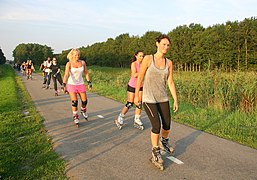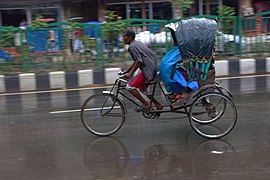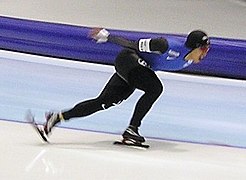Human-powered land vehicle
This article needs additional citations for verification. (May 2012) |

Human-powered land vehicles are land vehicles propelled over ground by human power, The main ways to support the weight of a human-powered land vehicle and its contents above the ground are rolling contact; sliding contact; intermittent contact; no contact at all as with anything carried; or some combination of the above.[1] The main methods of using human power to propel a land vehicle are some kind of drivetrain; pushing laterally against the ground with a wheel, skate, or ski that simultaneously moves forward; by pushing against the ground directly with an appendage opposite to the direction of travel; or by propeller. Human-powered land vehicles can be propelled by persons riding in the vehicle or by persons walking or running and not supported by the vehicle.
Many human-powered land vehicles can also be gravity-powered land vehicles, and vice versa, although some of the latter are quite awkward to use as the former. For example: street luges, gravity racers, and snow boards.
Types of ground contact
There are four main ways to support the weight of a human-powered land vehicle and its contents: rolling contact as with wheels; sliding contact as with skates, skis, or runners; intermittent contact as with stilts; and no contact at all as with anything carried. Additionally, these four methods may be combined as in wheelbarrows.
Wheeled
The most common wheeled human-powered land vehicle is the bicycle in all its forms. Other notable examples include:
- Balance bicycles and dandy horses
- Handcars, and draisines
- Hotchkiss Bicycle Railroad and shweeb
- Inline skates, roller skates, and roller skis
- Kick scooters, kickbikes, knee scooters, and square scooters
- Rickshaws, prams, strollers, roller buggies and buggies/Shopping trolley (caddy)
- Skateboards, longboards, Penny boards, snakeboards, caster boards, Freeline skates, Surfskate (or Carveboard)
- Tricycles, quadracycles, and velomobiles
- Trikkes
- Unicycles
- Wheelchairs and baby walkers
- Heel Skates
-
Cycling
-
Longboarding
-
Wheelchair
-
Rollerskating
-
Rickshaw
Sliding
-
Snowboarding
-
Ice skating
-
Sledding
-
Skiing
-
Clap skating
Intermittent
Types of propulsion
There are three main methods of using human power to propel a land vehicle: some kind of drivetrain that turns one or more drive wheels; pushing laterally against the ground, to the side relative to the forward motion of the vehicle, with a wheel, skate, or ski that simultaneously moves forward; by pushing against the ground directly with an appendage, such as a hand or a foot, opposite to the direction of travel, or by pushing against the air with a propeller.[2]
Drivetrain
Lateral motion of one or more wheels, skis, or skates
Direct contact with the ground
See also
References
- ^ Oxford English Dictionary (2nd ed.). 1989.
vehicle, n. 6. A means of conveyance provided with wheels or runners and used for the carriage of persons or goods; a carriage, cart, wagon, sledge, or similar contrivance. 7. a. Any means of carriage, conveyance, or transport; a receptacle in which anything is placed in order to be moved.
- ^ Melissa Wagenberg Lasher (2007). "The Propeller Trike". Popular Mechanics. Retrieved 2012-05-30.









